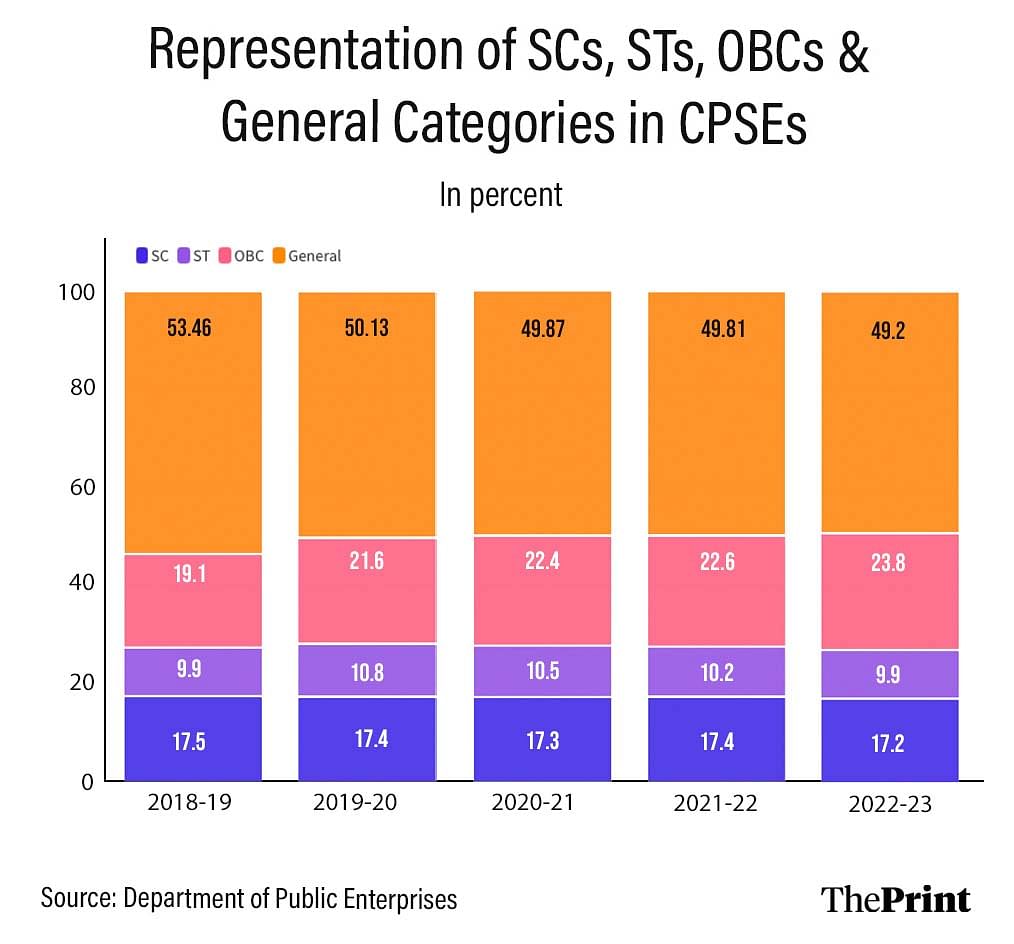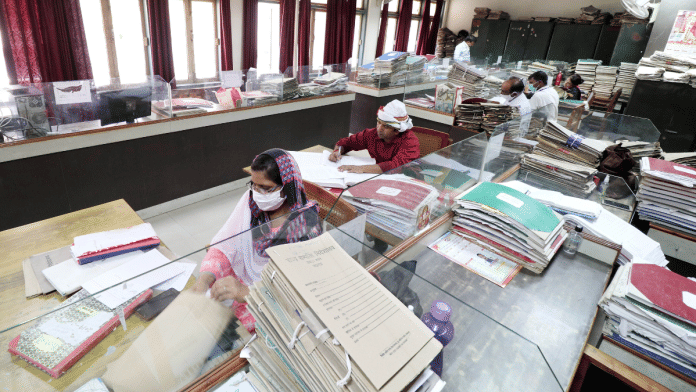New Delhi: The representation of Other Backward Classes (OBCs) in Central Public Sector Enterprises (CPSEs) has been improving, but is still lower than the recommended reservation benchmark set by Mandal Commission, employment data by the Department of Public Enterprises (DPE) shows.
ThePrint’s analysis of annual public sector survey reports — available only for the period from 2018 to 2023 — shows that the representation of OBCs in public enterprises rose from 19.1 percent in 2018 to 23.8 percent in 2023.
However, it is still below the recommended reservation of 27 percent, as suggested by the 1979 Mandal Commission.
The general category, which constitutes 15 percent of India’s total population, has the highest representation among employees in public enterprises at 49.2 percent.

The OBCs constituted 51 percent of the Indian population, including both Hindu and non-Hindu groups, the Mandal Commission estimated over four decades back
“The representation of SCs/STs/OBCs as on 31.03.2023 based on the information provided by operating CPSEs is shows that out 8.41 lakh total employees, 4.27 lakh employees are from the reservation category comprising 1.44 lakh (17.17 percent) from the Scheduled Castes (SCs), 0.83 lakh (9.86 percent) from the Scheduled Tribes and 2 lakh (23.77 percent) from the OBC category,” states the DPE’s annual public enterprise report of 2022-23.
Functioning under the Ministry of Finance, the DPE is entrusted with formulating policies and guidelines concerning the functioning and performance of public sector enterprises in the country.
The representation of Scheduled Castes (SCs) and Scheduled Tribes (STs) has been above the benchmark reservation quota of 15 percent and 7.5 percent, respectively, since 2018.
However, the data shows a marginal downward trend through the years. In 2018, SCs made up 17.5 percent of the CPSE workforce, which fell to 17.2 percent by 2023. Similarly, the percentage of STs in public enterprises decreased to 9.9 percent in 2022-23 after remaining above the 10 percent mark from 2019-2021.
Sudhindra Bhadoria, a member of the Bahujan Samaj Party (BSP), attributes the low representation of OBCs in public enterprises as compared to SCs and STs, to the delayed implementation of reservation.
“Reservation for OBCs was implemented very late as compared to other groups. Though the reservation in government offices has given OBCs more opportunities to enter the job sphere, the historical bias against them is still evident in most of the workplaces,” Bhadoria told ThePrint.
Way back in 1992, the Supreme Court had upheld the recommendations of the Mandal Commission for reservation for OBCs, and it was eventually implemented in September 1993. On the other hand, reservations for SCs and STs were implemented along with the Constitution in 1950.
Also Read: Sensex plunges 2300 points. Why a US jobs report caused Indian stock markets to crash
High OBC presence in highest & lowest grades
Employees in public enterprises are classified under four categories: Group A (managerial/executive positions), Group B (supervisory positions), Group C (skilled workers), and Group D (unskilled workers).
Out of those who are employed in these public sectors, most of the employees fall under the Group C category of employment.
Notably, the representation of OBCs among Group A employees has been increasing through the years, from 16.8 percent in 2018 to 23 percent in 2023. A similar trend is seen for SCs and STs as well.
At the other end of the spectrum, the number of OBC workers under Group D — unskilled workers, and therefore with the lowest wages — drastically increased from 14.6 percent in 2021-22 to 22.1 percent in 2022-23.
Ghanshyam Tiwari of the Samajwadi Party echoed Bhadoria’s contentions, saying that there has been a historical bias against these communities. He points to three reasons contributing to it.
“There is a systematic bias among those who are in power towards not giving the OBCs their due. The second is that there has been a historical continuation of the numbers from the past. As rules change, there could be a lagged effect because rules changed in the past few years,” said Tiwari.
The third reason, Tiwari said, is that some rules restrict OBC applicants from applying for certain jobs. Even if there are no restrictions, he added, officials often misuse the provision that allows organisations to hire general category candidates in reserved seats if there are inadequate applications from the reserved segment.
Representation of persons with disabilities
The data further shows that participation from the persons with disabilities (PwDs) category, too, is well below the 3 percent benchmark set aside for them.
In 2022-23, PwDs made up a mere 1.26 percent of the working population in public enterprises. The number, however, has been increasing year after year.
“The 254 operating CPSEs employed 10,574 Divyangjan employees as on March 31, 2023. The percentage of Divyangjan employees as a percentage of total employment was about 1.26% as on March 31, 2023,” the DPE report says.
“There is a general notion in the minds of people that the PwD segment is not as productive as others and are often considered medical liabilities at workplaces. It does not match the profitability cycle of organisations,” Bhadoria said.
The way forward
Both Bhadoria and Tiwari suggested stringent policy reforms and strong accountability when it came to ensuring the representation of OBCs in public enterprises.
“Unless there is accountability in place, it cannot happen,” Tiwari said. He added that there should be a mechanism to ensure that power is not misused and there aren’t any incentives that are working against the policy.
“It’s only now whether political parties, or civil society organisations, or local people in public life, are standing up with data to show this irregularity,” Tiwari said.
Bhadoria said that the glass ceiling needs to be broken and that people’s oppressive mindset needs to be changed. “The belief that the community that has been ruled cannot become rulers needs to change,” he asserted.
(Edited by Tony Rai)
Also Read: ‘Wait and watch’: RBI leaves interest rates unchanged for 9th time, projects growth at 7.2%






